Naturally, brands go where their target audiences are — which is why all successful companies have robust digital marketing strategies with a strong social media component. Particularly for consumer-facing enterprises, not advertising on social media has become unthinkable.
Of course, with so much content out there and people’s attention spans shorter than ever, plenty of competitors and other content creators are vying for your target audience’s attention. That’s why your efforts must be original, thumb-stopping, and cringe-less.

So, how do you ensure your social marketing ads truly drive engagement?
Don't worry; we're here with an in-depth guide on social media advertising. And yes — feel free to like, share, and subscribe.
What is social media advertising?
Before we get any deeper into the exciting world of social media advertising, you may be wondering — what does that even mean?
First of all, it’s important to dispel all the buzzwords and filler that most marketers out there are trying to fill your head with. At its core, social media ads are nothing more than an extension of your overall advertising and marketing strategy — as well as your brand’s online presence.
As a company, you'll write, record, and publish all kinds of adverts on social media websites like LinkedIn and Facebook. And they should be entirely relevant to your industry — when people follow a corporate account, they may expect some humour, but they don't expect nonsense.
Naturally, your social media marketing has two goals — to increase brand value by feeding into your wider advertising strategy and promoting specific services and products.
And while the format of social media may seem to constrain at first, especially to content marketers who are used to filling huge blog posts with walls of text — self-aware cough-cough — social media ads actually allow you to be at your most creative.
Look at it this way — it’s interesting, but perhaps more importantly, it’s entirely unavoidable.
On a daily basis, your social media advertising largely revolves around publishing visual content and adapting existing content into a social media format. In the long run, it can also involve cooperating with relevant influencers to further spread your brand message to potential customers.
The format also gives you a great opportunity for a community-focused approach. You can directly respond to customer questions, post engaging polls, and even engage in witty banter with other corporate accounts.
Why is it important to run paid social media ads?
If there’s one thing the biggest corporations and the smallest mom-and-pop businesses have in common, it’s the fact that everyone has expenses — and they’re loath to add more red to their bottom line.
So, why should you spring for paid social media ads when social media is basically free? Isn't the whole point building organic reach without incurring additional costs?
Well, yes and no.
All indicators show that the popularity of paid social ads has been steadily rising for the past decade — and since companies have begun investing more in their creative quality, engagement with online audiences has been rising as well.
That’s not all, though.
Reports like this 2019 study from Trust Insights clearly show that organic reach has been very much in decline, while paid ads have simultaneously been on the rise as they can reach a wider audience.
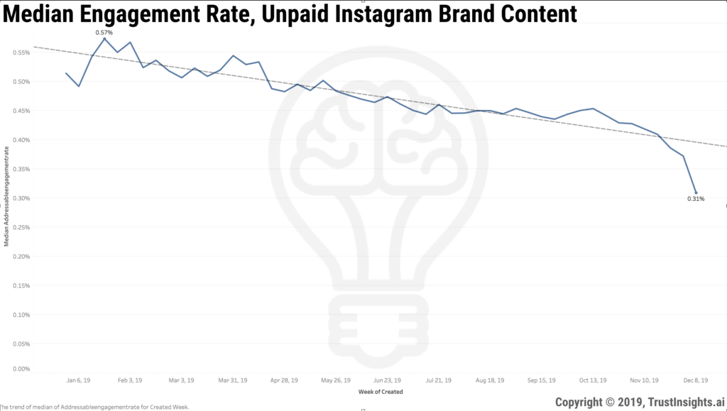
And no, that doesn’t mean organic reach is necessarily dead when curating social media posts.
However, it is under the sway of social media algorithms that can be quite fickle. At the end of the day, there are no guarantees that your unpaid posts are reaching the right audience. A part of your content could result in tons of engagement, while another chunk of posts may be practically invisible.
Conversely, paid social ads give you tangible, foolproof impressions. If you don’t want to worry yourself about restricted reach or whether you’ve pleased the almighty gods of the algorithm, but you still want eyes on your social media content — paid ads are definitely the way to go.
Plus, they allow you to specifically target the audiences you want to. While organic posts have you flinging a bunch of stuff against the wall and seeing what sticks, paid ad platforms of social media websites let you get pretty granular about whom you’re serving your ads.
Do you only want highly-paid millennial women in Sydney that follow specific social media accounts viewing your ad campaign for locally marketed beauty products? Go for it; there's nothing stopping you from specifying all of that stuff on Facebook Ads, for example.
While traditional display ads and older email cold campaigns were made to be one-size-fits-all, these ads are a lot more targeted. You’re paying for each view, but you can make sure every one of them is a prospective lead with the potential of being added to your customer base.
Also, scaling your online presence is practically impossible without a “push” via paid ads. Going the 100% organic way is a long-term, painstaking process. Without at least some paid ads, it can literally take years. And in the Internet era, years are basically decades.
So, rather than viewing organic and paid social media ads as strictly "either-or", try to see them as complementary tools for achieving the same goal. You can't constantly run sprawling, untargeted paid ads, or you'll bleed yourself dry, so a long-term organic game is still necessary. But on the other hand, you can't make it work without short-term paid ads either. It's precisely the "shot in the arm" your online efforts need.
How does advertising on social media work?
If the headline is “social media advertising works”, you’re right to ask — cool, but how does it actually work?
For starters, you need to understand that for social ads to be effective; they require tons of thorough planning. You'd be surprised at how the smallest details can (positively or negatively) affect your entire campaign and its reach.
Before you actually put together your social ads, you should become acquainted with how ad bidding and targeting work.
For instance, Instagram's and Facebook's ad platforms let you target users based on specific parameters like common interests, demographics, and age. You can also use your company's email list to target similar audiences to the leads you already have or only run campaigns for your existing website visitors.
How does social media advertising differ from organic content?
In terms of optics, your goal with paid social ad content should be simple — the only notable difference between it and an unpaid post should ideally be the tiny “Sponsored” tag it carries.
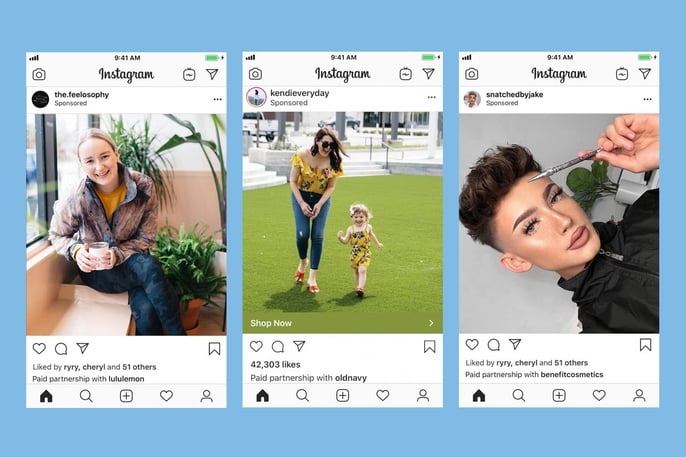
In other words, paid posts are supposed to:
- Be anchored to a specific promotion, service, or product
- Come with a suitable call-to-action (Click here, shop now, try our demo, etc.)
- Provide a link to a landing page tied to the specific promotion
You want your paid ads to provide the same level of content quality that your unpaid, organic content does. In that case, you’ll get a lot more of your money’s worth from each click you paid for.
What are some sample goals for social media ads campaigns?
Reach 1000 followers. Class dismissed...
Okay, it’s probably a bit more complicated than that — and don’t worry, we *will* get into more details. Obviously, “making money” is perhaps painting with broader brushstrokes.
In fact, speaking in practical terms, social media advertising is not actually always about chasing a profit on specific services and products.
The goals a company plans to reach through social media ads can differ wildly.
It all depends on your buyer's journey and marketing funnel. For example, you may be looking to bring more traffic and impressions to a website rather than actual purchases. On the other hand, your goal may be for social ads to be the remarketing tool you need to catch leads that bounced off your website before.
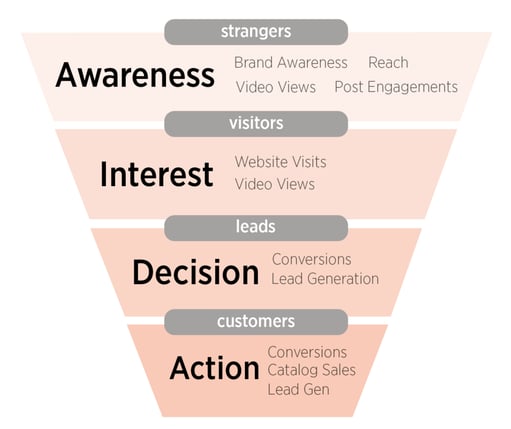
The best thing about social media is that it lets you optimise your approach for achieving it all.
Raising brand awareness
For instance, you may simply be interested in getting your brand in front of potentially interested customers — regardless of whether you’re retargeting to familiar customers or introducing your company to new people.
Lead generation
Are you on the prowl for ways to increase your demo downloads, email sign-ups, or just plain old website traffic? Don't worry; social media ads are there to funnel all of that lovely social traffic to your well-designed landing page that gets qualified leads on the right track to conversion.
Direct sales
At the end of the day, companies that are laser-focused on peddling their services and products will be looking to make direct sales through social ads — which works great for e-commerce stores. For example, you can use a series of Instagram or Facebook stories to introduce a time-limited discount on certain products or to present new collections to existing customers.
Brands that sell stuff online directly are rarely shy about directly showcasing products through social media — and they shouldn’t be.
What are some sample social media ad formats?
You’ve probably seen quite a few ads while browsing the vast reaches of social media yourself — but you may not be familiar with every specific ad format used on social media. Don’t worry, though; we’ll get you up to speed with some of the most popular formats that most industries and businesses can use.
Static image ads
While targeting on social media can become fairly complex, the actual content you’re presenting really doesn’t have to be. Just posting simple photos is fair game as long as you’re showing specific services, promotions, or products — or if you’re making announcements.
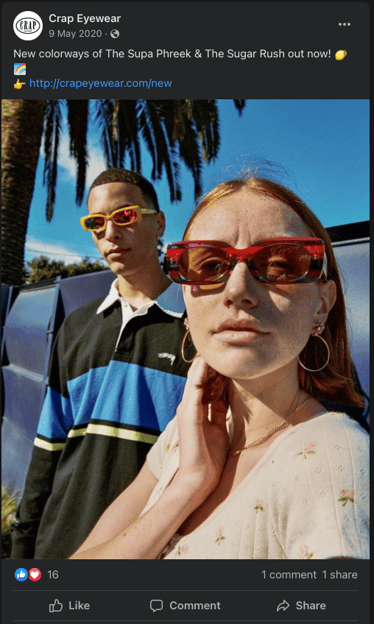
You know, stuff that people can immediately get behind without much fuss if you’re interested. A niche hipster clothing brand doesn’t always need a clever tagline — if their goods are solid, sometimes just posting a picture of them is enough.
Video ads
These days, it’s a well-known fact that video content is decidedly king on social media when it comes to engagement and popularity. Sure, static picture memes can become viral as well — but nothing spreads faster across the Internet than a funny video.
Even if users aren’t initially interested in what your company has to offer, video ads can naturally grab their attention while they go about scrolling down their endless social media feeds. Plus, the short-form video format brought to us by Snapchat stories is simply dying to be used for clever ads.
And best of all, their short nature means they remain accessible to companies with even the smallest marketing budget. All you need is some imagination and a phone with a camera — meaning any phone in existence today.
With that, you can create:
- Looping slideshows and images that attract the eye
- Real-time product demos
- Bite-sized company commercials
Carousel ads
You might've heard of carousel ads, but you don't know what they are. Don't worry; it's actually just a social media slideshow with a bunch of (potentially connected) pictures. And these carousel ads are especially potent on Instagram, where people are used to constantly scrolling vertically and horizontally.
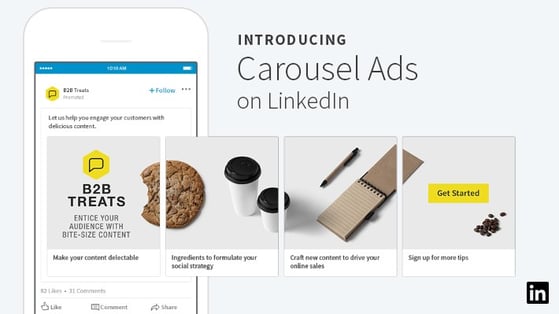
They allow you to easily showcase a bunch of your products at once or use the extra images to show off one product from multiple angles.
Also, carousel ads are inherently interactive because your viewers have an opportunity to explore a story by clicking through it — a mini buyer's journey unto itself. Using them in the right context can make people more at ease with engaging with all the rest of your products and services as well.
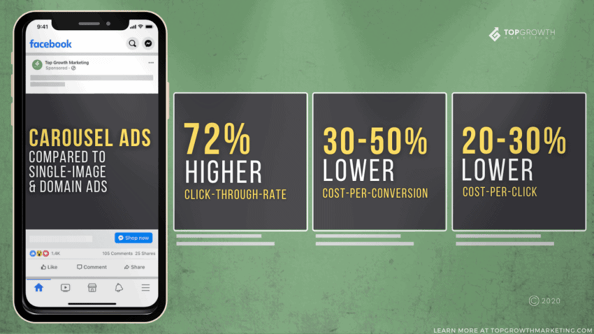
How do you optimise your paid ad strategy?
Okay, so maybe you’ve come up with a paid ad strategy — you’ve decided what kind of ad type will serve you best, and you’ve found the most relevant platform for your target audience. Now all that’s left is to create and publish your content — but in the most optimised way that brings you the biggest ROI on your online ad budget.
So, how do you do that?
You might’ve already guessed, but yeah — we’ve got a couple of great tips that you can use when you sit down to optimise your social media ads.
Find concrete goals
Okay, so we realize that your overall aim is to secure more leads or get more sales — but if you break that down into multiple steps and find smaller actionable goals, you’ll have a much better social media strategy.
For example, are you using a specific post to ramp up your CTR or to get more followers? Perhaps you’re aiming to direct traffic to a specific page on the company website? Give yourself some time to figure out what precise goals you’re aiming for with each post, and you won’t waste as much money on meaningless paid ads.
Understand your demographics
Naturally, knowing your audience matters — but it also pays to specifically tailor your presence on social media platforms to each individual platform.
Take a look at your social media channels as they are right now. Who’s following you on which platforms? Are these demographics the ones you had in mind when you started your online presence on Facebook or Twitter (for example) — if that’s not the case, then why?
When marketers have an unrealistic idea of the people they want to sell their stuff to, and completely different people are interested in the product in reality, a lot of paid ad money will end up going down the drain for nothing.
For example, if your Facebook stats are suggesting that college undergrads are predominantly interested in viewing your content, it’s something you probably want to factor into your broader content strategy — even if you’re not aware of it right now, there’s always a logical reason why some people are engaging with you and others aren’t.
Treat each platform individually
Many people don’t know how to strike a good balance between the need for a consistent brand image across all channels and the need to bend your content to the “house rules” of each individual social media platform you’re on.
While most people use and visit multiple social media platforms on a regular basis, each of them has its own nuances, customs, and rules — they’re each a contained Internet culture.
For example, Facebook is the place where you should share news relevant to your business and customer stories — while Twitter is perfect for bombastic, quick-fire updates and responding to practical customer queries.
On the other hand, Pinterest and Instagram are better for visual content and individual promotions and product showcases or inspirational content that’s more aesthetically pleasing. Finally, LinkedIn is a different beast altogether — it’s where you promote your company to potential employees and converse with like-minded professionals.
If you want to be consistent and yet relevant on every platform, you need to adapt your content accordingly and ensure you’re matching customer expectations at every point.
Consistency is crucial
While adapting your content to each platform is crucial, you should maintain some manners of consistency. For example, the visual look and feel of your Instagram feed posts should be consistent — it needs to be recognizable instantly when customers come across it on their feeds.
Also, you'll want to post at regular intervals and at specific times — it's a good business habit, and if you do proper targeting, you'll be posting when your target audience is checking their social feeds to help bump up those conversion rates.
Start using a content calendar
As we've already mentioned, proper planning is essential if you want to succeed on social media. Yep, it may all seem very spontaneous, creative, and carefree — but in reality, all the great social media ad campaigns are meticulously scheduled and thought out. As with every other kind of work, the trick is to make it seem effortless when it's completely the opposite.
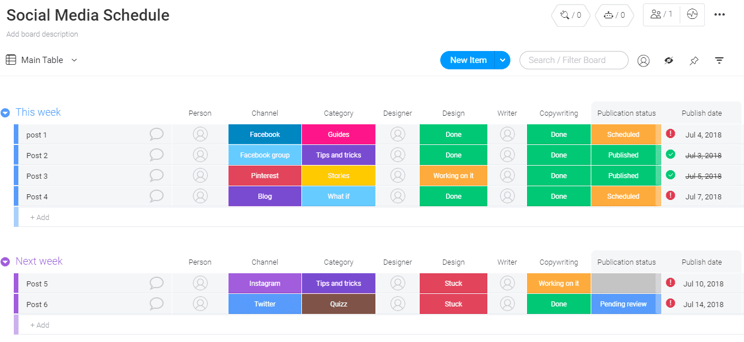
So, use a content calendar — it’ll become the central hub of all your social media ad activities for the months and years ahead. Apart from being a godsend in terms of scheduling, it’s also a nice overview of all your ad activities online.
Adapt to trends
Much like today’s 24-hour news cycle or the world of fashion, social media is all about trends — you always want to be in line with them, and you never want to be out of touch. While this gives online advertisers and marketers the chance to be quite flexible with their campaigns, it’s also a duty as much as it is a privilege — you don’t just *get* the chance to jump on whatever bandwagon is currently trending, you *have* to do it.
Always. Use. Video.
We can’t stress this enough. If you have failed to dabble in video content before, that’s pretty much the first thing you need to change about your social media advertising strategy. More than half of consumers consciously prefer looking at videos even compared to other visual content, let alone something as archaic as “words”. Ugh, yuck. Except when we do it. Then it’s cool.
Jokes aside, you don’t have to worry about renting out entire studios or getting expensive cameras. As we’ve said before, you can literally do it all with a smartphone. And if you’re running a small business, even better — your target audience will see you as more relatable if you don’t have a huge budget for your video content.
Focus on mobile and don't forget desktop
Well, you’re talking about social media — duh — most of it is on mobile.
Yes, we may be stating the obvious here, but it’s also important not to forgo desktop devices and tablets completely. Because yeah, half of the world’s Internet traffic comes from smartphones — but the other half still comes from desktops and laptops.
Never underestimate the number of bored office workers that can't be caught using their phones at work, so they access social media through desktop browsers on their work computers. In other words — create ads with responsive design in mind so that they can be properly viewed on multiple platforms. That way, you're maximizing your reach to every corner of your target audience.
Okay, a target audience doesn’t have corners — but you get what we meant.
What does the future hold for social media ads?
Even a quick dabble in social media platforms is enough for you to know that changes to their algorithms can quickly alter the landscape and shake up everyone’s ad strategies. With that in mind, it’s worth putting your ear to the ground when it comes to wider social media trends.
Think about how many people scoffed at TikTok in the beginning — right before it ballooned into one of the biggest video platforms on the planet thanks to younger demographics that weren’t sufficiently understood by marketers.
New functions like Twitter’s Fleets keep cropping up, and you’d do well to start finding ways to use them as your content platforms as soon as they appear!



